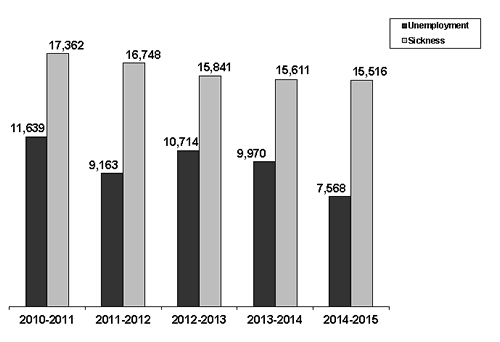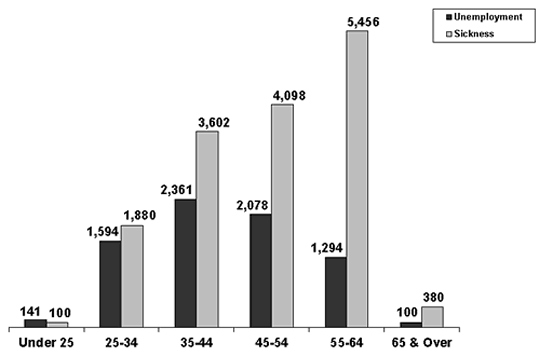Benefit Operations
Net unemployment and sickness benefits totaling nearly $79.2 million were paid in the 2014-2015 benefit year, $6.0 million less than in the prior year. In accordance with the Balanced Budget and Emergency Deficit Control Act of 1985, as amended by the Budget Control Act of 2011, amounts reflect a reduction of 9.2 percent for days of unemployment and sickness after February 28, 2013, 7.2 percent for days after September 30, 2013, and 7.3 percent for days after September 30, 2014. Beneficiaries numbered 22,500, in comparison to the previous year's total of 24,800. Nearly 600 employees received both unemployment and sickness benefits during the 2014-2015 benefit year. The number of unemployment benefit claimants decreased by some 24 percent, while sickness benefit claimants decreased by about 1 percent. Total net unemployment benefit payments decreased by nearly 23 percent, while net sickness benefits increased by about 7 percent. The number of employees qualified for benefits under the Railroad Unemployment Insurance Act stayed nearly constant, rising slightly to 248,200.
Benefits are payable for each day of unemployment or sickness in excess of 7 during the first 14-day registration period in a benefit year. During benefit year 2014-2015, there were 6,300 and 13,400 unemployment and sickness benefit waiting period claims, respectively.
| Note.-- Railroad unemployment and sickness benefits are paid on the basis of benefit years beginning July 1 and ending June 30 of the following year. Consequently, operational data in this Benefit Operations section are generally presented for this time span, rather than fiscal years beginning October 1 and ending September 30. |
Unemployment
About 7,600 railroad workers were paid $30.8 million in unemployment benefits during the 2014-2015 benefit year, including $0.3 million in recovered temporary extended benefits under the American Recovery and Reinvestment Act of 2009 and the Worker, Homeownership, and Business Assistance Act of 2009, as amended by the Tax Relief, Unemployment Insurance Reauthorization, and Job Creation Act of 2010, the Temporary Payroll Tax Cut Continuation Act of 2011, the Middle Class Tax Relief and Job Creation Act of 2012, and the American Taxpayer Relief Act of 2012. The number of benefit claimants decreased by some 2.400 from the prior year total of 10,000, while the benefit amount fell $9.1 million from the prior year's total of $39.9 million. The average number of compensable days per unemployment benefit claimant was 69 in benefit year 2014-2015, the same as the previous benefit year.
The mid-month unemployment count in the 2014-2015 benefit year began with a July count of 2,100 claimants. The count steadily rose during the following months until it peaked at 2,600 in November 2014. After November 2014, the count dropped in December before nearly repeating the same level in January 2015, then dropped again the following months until reaching a benefit year low of 1,800 in May 2015. For the 2014-2015 benefit year as a whole, the weekly number of claimants averaged 2,200 in comparison to an average of 3,000 in the previous benefit year. The overall unemployment benefit claimant rate, measured in relation to numbers of employees qualified to receive benefits under the Railroad Unemployment Insurance Act during a particular time period, fell to 3.0 per 100 qualified, from the previous year's 4.0 per 100 qualified, reflecting the continuation of normal unemployment levels. The median age for all unemployment benefit claimants was 43 years, as compared to 42 in the previous benefit year.
Sickness
The number of sickness benefit claimants during the 2014-2015 benefit year was 15,500, a difference of less than 100 lower than in the previous year. The benefit year claimant count was the lowest since sickness benefits began in benefit year 1947-1948. Gross sickness benefits of $67.0 million were paid, $2.9 million more than in the prior benefit year. Net sickness benefits totaled $48.4 million, reflecting repayment of a large amount of benefits following settlements of suits for injuries. Benefits payable for an injury are recoverable if the claimant is awarded damages or receives a settlement for the injury. Net benefits increased by $3.1 million in comparison with the previous year.
Major unemployment and sickness benefit operations,
benefit years 2014-2015 and 2013-2014
| Applications |
30,900 |
11,500 |
19,400 |
32,100 |
13,100 |
19,100 |
| Claims |
183,700 |
62,500 |
121,300 |
202,800 |
82,900 |
119,900 |
| Claimants |
22,500 |
7,600 |
15,500 |
24,800 |
10,000 |
15,600 |
| Net amount of benefits3 |
|
|
|
|
|
| |
$79,179,700 |
$30,751,900 |
$48,427,800 |
$85,183,000 |
$39,867,100 |
$45,315,900 |
| Number of payments |
|
|
|
|
|
Normal
Extended |
140,100
14,600 |
47,000
5,100 |
93,200
9,500 |
151,600
19,200 |
59,400
10,300 |
92,100
8,900 |
| Total |
154,800 |
52,100 |
102,700 |
170,800 |
69,700 |
101,100 |
| Average amount per 2-week registration period3 |
|
|
|
|
|
|
Normal
Extended
|
$577
541 |
$581
544 |
$575
539 |
$556
527 |
$553
529 |
$558
525 |
| Total |
574 |
578 |
572 |
553 |
550 |
555 |
|
1Starting in June 2009, includes temporary extended unemployment benefits authorized by the American Recovery and Reinvestment Act of 2009. Benefits had to begin by December 31, 2009. Beginning in November 2009, temporary extended unemployment benefits are also being paid under the Worker, Homeownership, and Business Assistance Act of 2009, as amended by the Tax Relief, Unemployment Insurance Reauthorization, and Job Creation Act of 2010, the Temporary Payroll Tax Cut Continuation Act of 2011, the Middle Class Tax Relief and Job Creation Act of 2012, and the American Taxpayer Relief Act of 2012. Benefits had to begin by December 31, 2013. The benefit year 2013-2014 amount totaled $2.4 million and the benefit year 2014-2015 amount totaled -$0.3 million.
|
| 2Benefits for both unemployment and sickness were paid to approximately 700 employees in benefit years 2013-2014 and 600 employees in benefit year 2014-2015. Those claimants who had only a non-compensable waiting period are not included in the beneficiary counts since no benefits were paid. |
| 3In accordance with the Balanced Budget and Emergency Deficit Control Act of 1985, as amended by the Budget Control Act of 2011, amounts reflect a reduction of 9.2% under sequestration for days of unemployment and sickness after February 28, 2013, 7.2% for days after September 30, 2013, and 7.3% for days after September 30, 2014. |
The utilization rate for sickness benefits was 6.3 percent of qualified employees, the same as the previous benefit year. The benefit year utilization rate was the lowest since the program's inception. The average duration of sickness was 66 days in benefit year 2014-2015, up from 65 in the previous benefit year.
Among the most common causes of sickness were injuries that included fractures or wounds (affecting 27 percent of beneficiaries), arthritis and disk disorders (22 percent), mental disorders, including drug and alcohol addictions (12 percent), and symptoms, signs and all ill-defined conditions (9 percent). The median age of all sickness benefit claimants was 50 years, the same as the previous benefit year.
Claimants under the Railroad Unemployment Insurance Act,
Benefit Years 2010-2011 through 2014-2015

Unemployment and Sickness Benefit Claimants By Age,
Benefit Year 2014-2015
